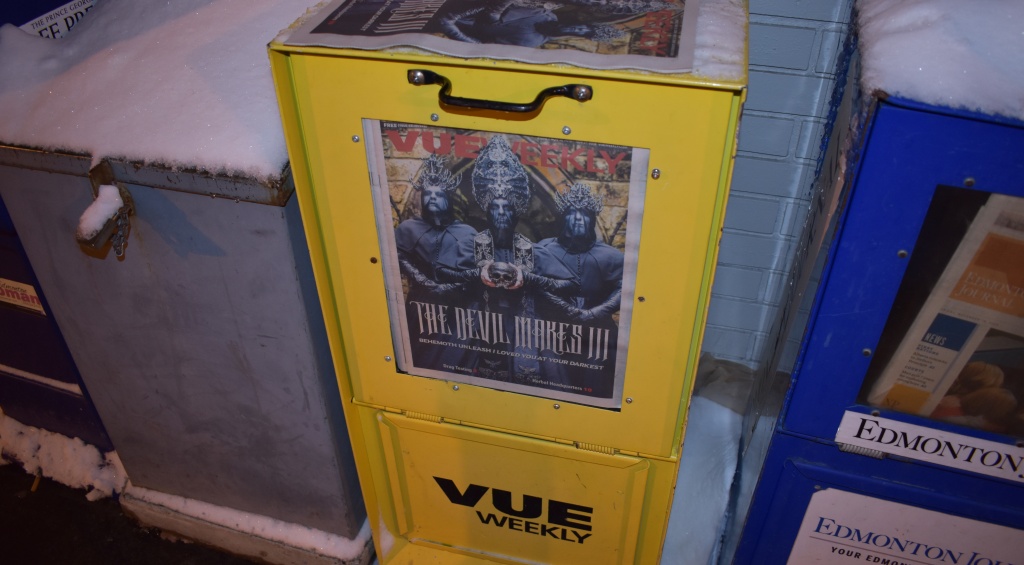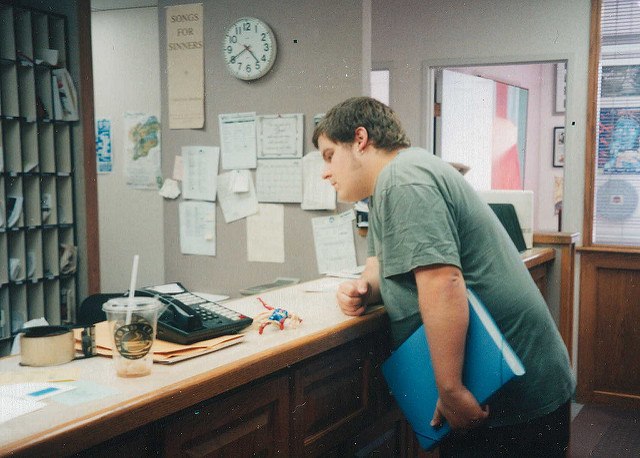What happened to VUE Weekly?
Posted on November 16, 2018 By Gene Kosowan Entertainment, Front Slider, life, News, news
 Stop the presses – for good.
Stop the presses – for good.
That may or may not be part of the last rites for VUE Weekly, the city’s venerable alternative newsweekly that lasted nearly a quarter-century. It drops its final issue on Nov. 29. In a city that used to support at least two rival publications until seven years ago, the arrival of December will also witness a print void in alternative media that hasn’t been seen since the 1980s.
VUE is relegated to burial with other local alternative rags that preceded it, such as Culture Shock, their once-bitter rivals SEE Magazine, and The Edmonton Bullet – which started the Edmonton’s alternative press movement nearly four decades ago.

Steven Sandor back in the day
“You feel for the staff there now,” says current Avenue Magazine editor Steven Sandor, who was VUE’s managing editor nearly 20 years ago. “With so many media outlets that are closing, you feel for the people who are affected. VUE has been a place where writers cut their teeth. A lot of people got their starts there before moving on to bigger things. Those were opportunities that are now lost.”
With readership and advertising revenue on the decline, owner PostVue Publishing decided to axe the mag before it became unprofitable. Company president Robert Doull said that the office will remain open, to continue with specialty publications, such as Hot Summer Guide and Cool Winter Guide that used to be included as inserts.
“VUE did not fail; it’s not bankrupt,” said Doull, who’s seen the page count of the publication dwindle from 78 to 24 in the space of six years. “Fewer people were picking it up and we had few resources to put into it. So we thought: why don’t we spend our time and energy into something that’s growing instead? This isn’t it anymore.”
Doull sees growth potential in the specialty guides, which at 100,000 copies per run, is five times the circulation VUE currently has. To help out with the online components, he’s bringing on board the digital agency arm of St. Albert-based Great West Publishing – a company that had an adversarial history with VUE.
Great West Publishing president Brian Bachyinski didn’t let on about any previous conflicts, but since the start, VUE’s existence has been inextricably tied with his newspaper publishing and print company. The story has more plot twists than a soap opera.
In 1991, an upstart monthly called Something Entertaining sprung up along Whyte Avenue; it was the brainchild of pony-tailed entrepreneurial maverick Ron Garth. The magazine didn’t last long, but Garth took another swing at the publication trade and launched SEE as a weekly tabloid in 1992 – and connected big-time. The magazine became so successful it absorbed The Edmonton Bullet and expanded to a circulation of more than 32,000.
It also had a massive print bill that its creditor, Great West, wanted paid in full or would threaten to put SEE into receivership. Rather than go down with the ship, Garth and a core staff embarked on a midnight move to a bungalow in Old Strathcona, where two employees lived. The crew also took what was needed to start another mag – and the first edition of VUE Weekly was on the street within half a month. Great West held onto what was left of SEE and continued to publish, this time hoping to beat VUE where it counted: on the street.
“That was kind of fun,” Sandor says said. “Putting the magazine out in the basement the first couple weeks after the shotgun move, the court injunction that Great West had against us, there was a sort of irreverence going on from our end and we were figuring out what we could get away with.”
At times, there was controversy – especially from cartoons by James Grasdal. While garnering a rabid following (that continues to this day in newspapers across North America), the cartoonist took a lot of heat over illustrations that included former city councilor Tooker Gomberg in a noose (Gomberg committed suicide in 2004 in Halifax, years after a failed Toronto mayoralty bid.). A caricature of then-Reform Party leader Stockwell Day prompted an angry phone call from the politician’s brother.
“I don’t know if what we put out was great, but we had a great time doing it,” recalls Grasdal – who was eventually fired from VUE for a cartoon portraying an Edmonton Catholic School superintendent as a snake in the Garden of Eden.
Sandor recalls getting feedback from readers after the mischievous staff altered the masthead so that everyone had Star Trek designations. He also took on an angry record store client who complained about VUE’s pans on releases the outlet had on display. Sandor replied, “So, stop trying to sell crappy music!”
That piss-and-vinegar attitude got VUE through some rough times in the lengthy war with the Great West-owned SEE – a conflict that even divided much of the city’s cultural community.
“Back then, you had to pick a side,” Sandor says, “and when you did, it was non-negotiable. It was either us or them.”
The battle ended in 2011 when Garth sold VUE to Doull, who had also bought SEE at a time when Great West was apparently throwing in the towel. The acquisition brought much of his competitor’s talent to operate under the VUE umbrella, and uniting the best of two former warring camps gave hope that one strong alternative publication serving the city would lead to some semblance of stability.
By then, VUE and other publications around the continent were facing an even bigger threat: The Internet. The advent of social media, the devaluing of traditional (print) media, and an unpredictable economy took its toll on the alternative newsweekly market. The landscape shift has already sucked under Toronto’s Eye Weekly and Calgary’s FFWD, and others. In America, the deluge is more pronounced with the demise of the industry’s flagship Pulitzer Prize-winning Village Voice, the Boston Phoenix, and the San Francisco Bay Guardian.
Doull noticed those same seismic signals: including theatre companies that used to spend as much as $30,000 annually on ads with VUE, and now only spend half as much these days, spreading the rest of their expenditures across social media. He recalled how changes in oil prices would leave most music venues owing the magazine money for ads.
“The music industry has its own challenges; it’s very difficult to run a live music venue and make it successful,” said Doull. “Seriously, when was the last time you saw a full-page music ad in VUE?”
Two years ago, Doull restructured VUE and hired a younger editorial staff to attract the fickle millennials, but risked losing a demographic that’s roughly 45 years and older. That did nothing to reverse the flow of advertising and audiences, although he said he received more than an earful from longtime readers complaining they couldn’t relate to any of the content.
Writer Stephan Boissonneault, the last VUE editor, was given the bad news on Wednesday. With two more editions to go before it goes belly-up, he’s coming to grips with how to go about documenting Edmonton’s music scene.
“I really thought there was more that could have been done,” he says. “A lot of music isn’t going to get covered now that VUE is gone.”
In their prime, newsweeklies like VUE did it all, from covering material that more mainstream media wouldn’t even touch, to becoming springboards for fresh talent to reach higher media rungs. Even sports.
“It really represented a time when you wanted to stretch your legs,” says Sandor. “Even though I had worked in small town newspapers, it’s weird that in some way being at an irreverent alternative newsweekly like VUE was the thing that helped me get into a mainstream media career.”














2 Responses to What happened to VUE Weekly?